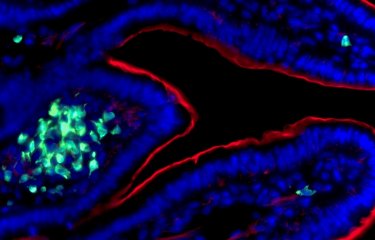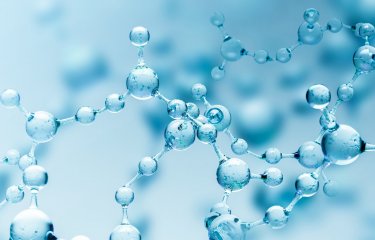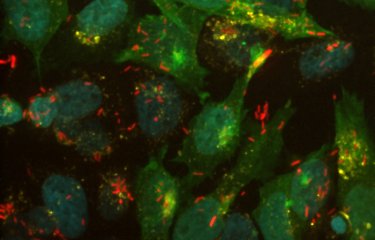The Escherichia coli bacterium is a major focus of research in biology. But the higher-order organization of its genome had yet to be investigated using techniques such as chromosome conformation capture (3C/Hi-C). In a paper published in the journal Cell, scientists from the Institut Pasteur revealed using this approach the existence of several levels of chromosomal folding linked to known proteins, including condensin and the histon-like HU protein, whose roles in maintaining the structure of this genome were until now unclear.
"All genomes must be specifically organized to ensure they function correctly, for instance to regulate the access to the genetic information they contain, explains Romain Koszul, Head of the Spatial Regulation of Genomes Unit at the Institut Pasteur. Bacterial genomes, which are generally made up of a single circular chromosome, are no exception." This chromosome is organized in a structure called a nucleoid, which at the same time enables gene regulation and the segregation of replicated chromosomes. The findings of previous research carried out on different bacterial species showed, or suggested, that nucleoid formation is a result of different processes:
- DNA molecule supercoiling,
- macromolecular crowding,
- processes such as transcription,
- formation of a bacterial chromatin resulting from proteins binding to DNA,
- and finally the condensation of DNA by condensin-type proteins.
An omics approach to study contacts between DNA segments…
By using different approaches combining genomic methods (chromosome conformation capture or 3C/Hi-C), genetic methods and fluorescence microscopy, scientists from I2BC (CNRS, CEA, Paris-Sud University, Paris-Saclay University), the Institut Pasteur, the Collège de France and Pierre and Marie Curie University studied the impact of several factors controlling chromosome folding and multiscale organization in the model bacterium Escherichia coli. How? By analyzing the organization of chromosomes from different E. coli mutants using the 3C technique, which quantifies the physical contacts between segments along DNA molecules, and ascertains their relative positions.
In doing so, the scientists were able to determine the influence of transcription regulation on the local DNA structure, and the roles of the main proteins associated with the nucleoid on the 3D organization of the chromosome. "We have identified two methods of communication in the chromosomal DNA which define two separate structural entities – the ter region, the part of the chromosome where genome replication ends, and the rest of the chromosome", explains the scientist.
… and shed light on the role of some proteins
The first method of communication, which is consistent in the main part of the chromosome, apart from the ter region, enables long-range contacts in the DNA. These contacts are the result of the combined action of the bacterial condensin and HU protein. While it is not surprising that condensin activity stimulates contacts between distant DNA sites, a role for the ubiquitous proteins HU in promoting such long-distance interactions in vivo had never previously been described, opening up new avenues for research.
The second method of communication regulates the ter region where a protein, MatP, prevents condensin activity, thus isolating this region from the rest of the genome. "Here, MatP has a structure regulator role to play by preventing the condensin to promote contacts between distant sites in the ter region", and this challenges a model whereby this protein, on the contrary, bridged distant regions.
New avenues using omics technologies
The research reveals multiscale chromosome conformation involving proteins with different and unexpected properties to control chromosome dynamics. When combined, the findings highlight the unique properties of the ter region in E. coli and show how this species has selected strategies that confer specific and distinct properties to this chromosomal region that are different for example from other bacteria such as Bacillus subtilis.
These key discoveries are vital for understanding bacterial chromosome metabolism. They also show that the ubiquitous and very abundant DNA-binding proteins such as HU, which have long been known to interact with DNA but whose roles remain unclear, are important for the multiscale structuration of the chromosome in vivo. 3C-type genomic methods, which are widely used in eukaryotes but relatively seldom in bacteria, demonstrate here their relevance for studying nucleoid function.

Source
Multiscale structuring of the E. coli chromosome by nucleoid-associated and condensin proteins, Cell, February 8, 2018.
Virginia S. Lioy 1*, Axel Cournac 2,3*, Martial Marbouty 2,3, Stéphane Duigou 1, Julien Mozziconacci 4, Olivier Espéli 5, Frédéric Boccard 1#, Romain Koszul 2,3#.
1. Institut de Biologie Intégrative de la Cellule, CEA, CNRS, Université Paris-Sud, Université Paris-Saclay, 91198 Gif-sur-Yvette Cedex, France
2. Institut Pasteur, Département Génomes et Génétique, Groupe Régulation spatiale des génomes, 75015 Paris, France
3. CNRS, UMR 3525, 75015 Paris, France
4. Sorbonne Universités, Laboratoire de Physique Théorique de la Matière Condensée, UMR 7600, Université Pierre et Marie Curie, 75005 Paris, France
5. Centre Interdisciplinaire de Recherche en Biologie, Collège de France, UMR-CNRS 7241, INSERM U1050, Paris, France





